Description:
This is a variation of the electron beam lithography technique, using an focused ion beam (FIB) instead of an electron beam. In a similar setup to scanning electon microscopes, an ion beam scans across the substrate surface and exposes electron sensitive coating. A grid of pixels is superimposed on the substrate surface, each pixel having a unique address. The pattern data is transfered to the controling computer, which then directs the electron beam as to realize the pattern on the substrate pixel by pixel. The ion beam used is either a Guassian round beam or Variable Shaped Beam (VSB). There are two methods of scanning the beam over the substrate surface to write the pattern data. With raster scan, the electron beam is scanned across lines of pixels and the wafer is shifted to the next line. With vector scan, an area of an individual chip is selected, and the beam draws out the features in that area one-by-one.

Diagram of a setup similar to the basic ion beam lithography setup. The electron gun would be replaced with a ion beam source.
Advantages:
- Computer-controlled beam
- No mask is needed
- Can produce sub-1 µm features
- Resists are more sensitive than electron beam resists
- Diffraction effects are minimized
- Less backscattering occurs
- Higher resolution
- Ion beam can detect surface features for very accurate registration
Disadvantages:
- Reliable ion sources needed
- Swelling occurs when developing negative ion beam resists, limiting resolution
- Expensive as compared to light lithography systems
- Slower as compared to light lithography systems
- Tri-level processing required
Ion Beam Resists:
These are materials which exhibit changes, whether physical or chemical, due to exposure to a high-energy ion beam. Most ion beam resists are polymer chains. Some optical resists can also be used. Several ion beam resists are self-developing, in that exposure to the ion beam completely disintegrates the substance.
Positive Resists
Positive ion beam resists break down into less complex fragments on exposure to an ion beam. Because the less complex fragments have a lower molecular weight, they are more soluable by the developer than the unexposed resist.
Negative Resists
Negative resists form complex molecular links when exposed to the ion beam, and so become insoluable in the original solvent, which removes the unexposed resist.
Certain inorganic resists can also be used. A layer of GeSe onto which AgSe has been evaporated, acts as a negative resist. When exposed to the beam, the GeSe layer is filled with AgSe, and the combination can then be developed.